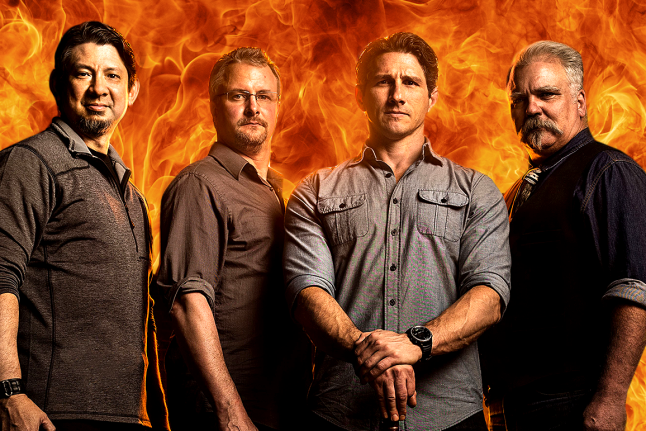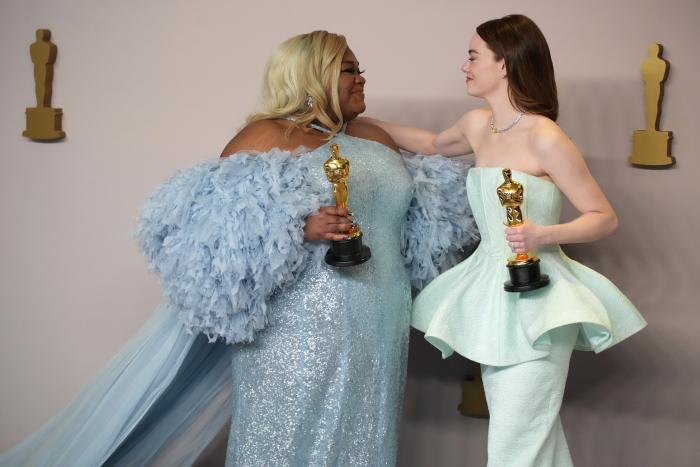

Review: 'Forged In Fire' Is A Charming Challenge To Toxic Masculinity
By Kristy Puchko | TV | October 8, 2018 |
By Kristy Puchko | TV | October 8, 2018 |

Is there a more macho hobby than bladesmithing? Watching the reality TV competition Forged In Fire, I’m hard-pressed to imagine one. Here, men bend metal to their will with fire, muscle, and lots of pounding. This is a deeply macho show, where the contestants drip with sweat from the heat of the forge fires, where their weapons are tested by an all-male panel of judges, and where slow-motion is intensely slathered on close-ups or forges, tools, and swipes of newly made blades. And yet for all this machismo, Forged In Fire provides a wide array of positive male role models, men who relish being masculine, yet are happy to share their softer side. It’s like they all come from the Nick Offerman school of manhood!
I knew exactly nothing about bladesmithing when I stumbled across this History Channel show on my hotel’s TV. And that will become very obvious as I struggle to describe the show. But look, I’m not here for the sockets and canisters and—uh—billets. I’m here for the men who managed to be passionate and manly without being competition-crazy, agro-dickheads.
The show has three rounds. In the first, four contestants must make a blade. After one contender is cut, the remaining three will complete their weapons by attempting to address the panel’s notes on their forged metal, and adding a handle. The two best from this round will then have 5 days to go back to their “home forge” (that’s a thing people have!) to make one weapon from history, like (checks notes) a Russian pioneer sword, Bagh Nakh, and the Wind and Fire Wheels. And then they come back to the studio to have their weapons tested. (It’s usually on a pig or deer carcass, which was a section I watched through my fingers because this human substitution is still pretty grisly, and a wee bit disturbing as the judge cheerfully proclaims of weapons that pass muster, “It will kill!” But I mean, they’re making weapons. That is the point.) The weapon that cuts and holds up the best wins, and that contestant gets $10,000 and the honor of being a Forged in Fire champion.
Over the course of several episodes, I saw a variety of men come to the forge. Some wore bold facial hair, ranging from groomed hipster beards, to biker-style handle-bar mustaches, to the bushy face ‘do of a wily prospector. They came scrawny, brawny, and fully beer-bellied. They came young and old. But whatever motley crew assembled, they shared an easy camaraderie that overtakes the competition. When one man’s billet balks or the quench warps a blade, there’s no rejoicing in your competitor’s misfortune, because they’ve all been there. They offer words of encouragement or a helping hand. As they await judgment, they share stories, not insults. When a blade suffers a “catastrophic failure” of snapping in two as it is smashed against a paint can, they offer commiserating back pats. When a sword slices clean through a deer’s torso with one mighty swing, there’s congratulations, high-fives, and sometimes hugs. These bladesmiths are brought together by their shared love for their craft. And watching Forged In Fire, I couldn’t help but remember the barking man-babies of Ink Master, who not only seek to sabotage each other—even when live flesh is on the line—but also wail, curse, and insult each other as if that is the true measure of their manhood.
Even cooking competitions like Cutthroat Kitchen or Hell’s Kitchen urge contestants to trash talk about their competitors or bash the judges who send them packing. But on Forged In Fire, there’s a pleasantly surprising level of chill. Contestants walk away disappointed, but not outraged. “I’m not happy to be going home,” one contestant said with a shrug, but then went on to agree the judges made the right call, concurring that his competitor bested him that day. Despite the fact that this is a competition show with a juicy cash prize on the line, these guys play like they have nothing to prove. They don’t think their identity is on the line. Losing this show won’t warp their love for blade-smithing or chip at their manhood. And so we get to watch people who are deeply dedicated to this difficult craft do it with unique challenges and revel in every minute. But Forged In Fire, does more than show us these men at work. It gives us a peek at them in play.
In one episode, two contestants forged a fast friendship, and the rest of the ep included soundbites of their budding “bromance.” In another, a contestant said in an interview that his interests outside of bladesmithing include, “art” and “cats.” Another contestant took a break from his home forge to play with his infant daughter, and when he won, noted with a broad grin that a portion of that 10 grand would go to getting her a “whole new wardrobe!” These are men who need not be constrained to some rigid casting of what a man is, and they are celebrated for it through the show’s spotlighting of these moments.
There’s also a cheery recognition of some of bladesmithing’s less glamorous aspects. The men often complain of the unholy stink they exude after a long day in the forge. In one episode, a contender accidentally lost his axe-head into a large barrel of quenching liquid, thick and black with gunk. The judges all cried out in comic dismay as they watched the poor guy reach an arm into the muck to retrieve it, all acknowledging how gross it must feel! When injuries happen, these men don’t curse or carry on, but gamely chuckle at their mistakes, playfully pointing to a band-aid in the middle of a split nose, or narrating, “Ow! You hit yourself in the belly! And that’s going to be on TV!.” And through all this, we see a softness and silliness that doesn’t make these guys less of a man, only more human.
The refreshing lack of aggression means that Forged in Fire focuses on the bladesmithing and the people* who love it. Though they make weapons, these are not violent or agro bros who promote the idea that being top dog means being the biggest dick. The only thing they measure is their weapons, and that’s just to be sure they meet challenge requirements. These contestants embrace camaraderie over competition, and so present themselves as a community that is exciting and inviting. And all of this—the passion, the craftsmanship, the fraternity—not only makes Forged in Fire a joy to watch, but also a powerful example of non-toxic masculinity.
*Wikipedia tells me there are occasional female contestants, but none were in the eps I saw.
← 5 Shows After Dark: 'Better Call Saul' Season 4 Finale, 'RX Early Detection: A Cancer Journey with Sandra Lee' | Spoopy True Stories Of Creppy Incidents →
More Like This
One Of The Stars Of 'The Hangover' Is Joining 'Only Murders In The Building'
A Legendary Horror Franchise Is Headed To Television
Trying To Make it Through the Oscars
Josh Brolin Hosts 'SNL' but Ariana Grande and Scarlett Johansson Steal the Show
One Ruthless Move Saved an Otherwise Uneven Season of 'Traitors'

What’s Old Is New Again: Old Hollywood Glamour Glitters at the 2024 Oscars
Al Pacino Presents Best Picture Oscar, Confuses Everyone
The Dangerous Lie Of 'TradWives'
A Legendary Horror Franchise Is Headed To Television
'The Mandalorian' Season 4 Is Probably Not Happening
Halle Bailey On Why She Chose To Keep Her Pregnancy Private
More Like This
One Of The Stars Of 'The Hangover' Is Joining 'Only Murders In The Building'
A Legendary Horror Franchise Is Headed To Television
Trying To Make it Through the Oscars
Josh Brolin Hosts 'SNL' but Ariana Grande and Scarlett Johansson Steal the Show
One Ruthless Move Saved an Otherwise Uneven Season of 'Traitors'
Reviews